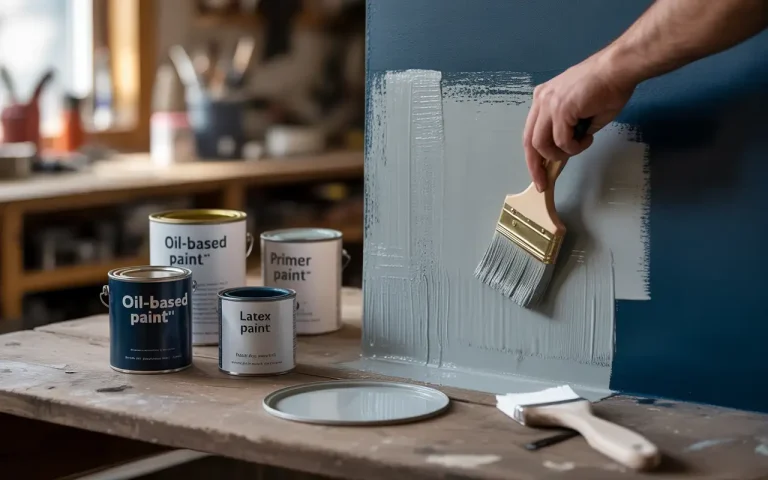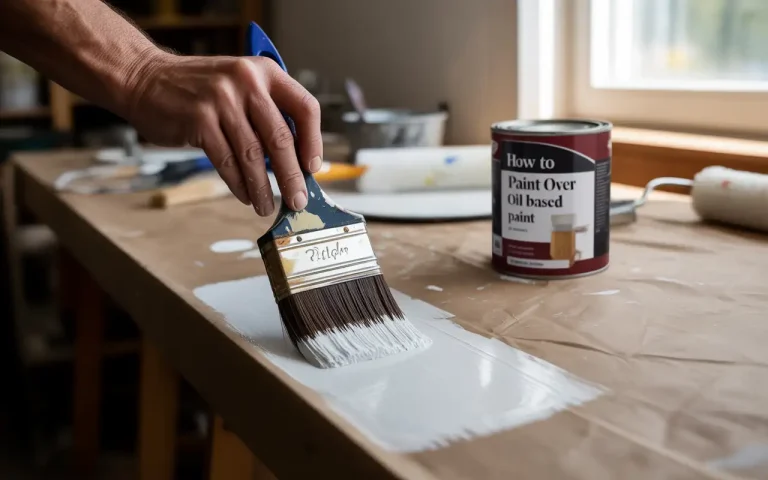How to Paint Over Oil Based Paint: The Right Way (2025)
Painting over old oil-based paint can be difficult without proper prep. The paint won’t adhere properly, or it may just peel later. This guide explains how to paint over oil-based paint correctly with durability in mind.
You will also learn the tools, best primers, and the conditions when it makes sense to paint over with oil-based paints again. Whether painting walls, trim, or cabinets, this will help you paint over oil-based paint correctly.
Table of Contents
ToggleBenefits of Water-Based Paint
Today, many homeowners prefer using water-based paint over oil-based paint because it dries more quickly, has much less odor, and is easier to clean. When working in an older home, at some point, you may still find oil-based paints on your trim or cabinets. However, the reasons to switch to water-based paint (acrylic, latex) are compelling.
Another reason water-based paint is better for your health and the environment is that water-based paint has very low amounts of VOCs (volatile organic compounds), making water-based paint much safer for indoor use. Also, water-based paint does not yellow and provides a smoother finish than oil-based paint on an indoor painted surface.
When it comes to painting over oil based paint, water-based paint is usually the smarter long-term choice as long as the surface is prepared the right way.
Feature | Water-Based Paint | Oil-Based Paint |
Drying Time | 2-4 hours | 8-24 hours |
Cleanup | Soap and water | Chemical solvents |
VOC Emissions | Low | High |
Color Retention | Excellent | May yellow |
Maintenance | Easy touch-ups | Complex repairs |
How to Paint Over Oil Based Paint with Water-Based Paint

1. Checking the Surface
The first step is determining whether your wall or trim surface is finished with oil-based paint. To do this, use the denatured alcohol test. To do this, rub a cloth wet with denatured alcohol over a small inconspicuous area. If paint comes off, that paint is water-based. If not, it is oil-based.
2. Cleaning the Surface
Clean the surface area with warm water and a cleaner like trisodium phosphate (TSP); ideally, this is done before the above step. Doing this will kill grease, dirt or any build-up that will impede adhesion.
3. Sanding Glossy Surfaces
Most oil-based paints dry hard and glossy, making them ideal for the last step to dull the surface for better or perfect adhesion. Sand the surface lightly using oily or glossy sandpaper, and then clean the sanding dust off the surface.
4. Utilization of the Appropriate Bonding Primer
This is an integral step. A good bonding primer will help the water-based paint stick to the old oil-based surface. Obtain a primer that says it is for use over glossy finishes or oil-based finishes, and premium products such as Zinsser Cover Stain, Kilz Adhesion, and INSL-X STIX all work well.
Also, let the primer dry completely before moving on to the next step.
5. Apply Water-Based Paint
Now you’re ready to paint using a good-quality acrylic or latex paint for the best quality. Use 1-2 thin coats and allow for complete drying in between coats. No need to rush.
Pro Tip:
Some of the best bonding primers for painting over oil based paint are:
- Zinsser B-I-N (shellac-based)
- Kilz Original (oil-based)
- Kilz Adhesion (water-based bonding)
- INSL-X STIX (great for glossy surfaces)
Tips for Painting Over Oil-Based Paint with Oil-Based Paint

Painting oil over oil is a logical choice since it is naturally complementary. Oil-based paint can generally bond well to a surface that has oil-based paint, without an extensive amount of preparation. This is an appropriate method if you are painting a high-traffic area, or areas that are prone to moisture, and maximum durability is required- such as on a door or the `splash zone` of a sink.
Because you are painting over an existing, or previous oil-based paint, surface preparation does not require much. General cleaning and light sanding are enough. The existing oil base will give you enough hold for applying new oil coatings to the surface.
Use good brushes and rollers that are made to work with oil-based products. As mentioned earlier, the best brushes to use are natural bristle brushes made for oil formulations. When using oil-based paint, you should also make sure you have a proper amount of ventilation for both application and drying. Oil paints release more fumes than water-based paints.
The best solution will be to clean brushes and related tools using the appropriate solvents. Typically, you will need `mineral` spirits and/or paint thinner. Always follow the manufacturer’s recommendations for cleaning brushes or tools and disposal of any waste product.
Ideal Primers and Topcoats for Painting Over Oil-Based Paint
Using the right primer makes all the difference. Here’s a quick guide on what to use and when:
Primer Type | Use For | Recommended Products |
Shellac-based | Glossy surfaces, stains, odor blocking | Zinsser B-I-N |
Oil-based | Tough surfaces, wood trim | Kilz Original, Zinsser Cover Stain |
Water-based (bonding) | Glossy surfaces, switching paint types | Kilz Adhesion, INSL-X STIX |
When choosing topcoats, stick with latex paints if you’re switching to water-based or a fresh oil-based coat for high-wear areas. For cabinets or doors, look for paints labeled as “trim enamel” or “interior enamel” for added durability.
The Perfect Paint Job Every Time – Guaranteed!
The secret to a great paint job is simple: Prep. Prime. Patience. Skipping any step can lead to peeling, streaking, or dull finishes.
Common mistakes to avoid:
- Not sanding glossy surfaces
- Using water-based paint without primer
- Painting over dirt or grease
If you want a flawless finish without the guesswork, trust a professional. At San Diego Custom Painting, we deliver high quality results that last. Whether it’s an older home or new construction, our team handles it all.
Check out our exterior painting and interior painting services in San Diego to get expert help and ensure your project is done right the first time.
Need advice or a custom quote? We’re here to help.
FAQ'S
Can you paint over oil-based paint with regular paint?
Yes, but only if you prepare the surface and use a bonding primer first. Without prep, the new paint won’t stick. Latex paints can go over oil-based if you sand and prime correctly.
What paint will stick to oil-based paint?
Acrylic and latex paints will stick if used with a proper bonding primer. Without primer, water-based paint may peel off glossy surfaces.
Can I paint over oil paint without sanding?
It’s not recommended. Sanding helps remove gloss and roughens the surface for better bonding. If you skip sanding, use a deglosser or a high-adhesion primer.
What primer to use to cover oil-based paint?
Use bonding primers like Kilz Adhesion, Zinsser Cover Stain, or INSL-X STIX. These are made to stick to oil-based coatings and glossy surfaces.
Can Kilz 2 be used over oil-based paint?
No. Kilz 2 is water-based and not strong enough for glossy, oil-coated surfaces. Use Kilz Original or Kilz Adhesion instead.
